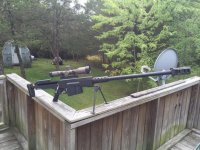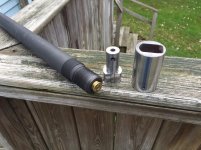Hello,
I'm a European engineering student (and hunter/gun owner) spending some of my free time daydreaming about designing the most awesome rifle. I've got an idea of what I want the rifle to do but I'm kind of exploring the technical possibilities to determine if it's realistic to realize my concept rifle. So I'm not doing finite element analysis or anything like that but I'm doing rough estimations and ballpark figures to see where I am relative to reality.
Anyway...
My rifle will probably use an aluminum receiver with the locking lugs cut in a steel barrel extension. I'm trying to figure out how to mate these two together. There are a bunch of factors to think about:
i) Able to keep the barrel pointing in the right direction
ii) able to prevent the barrel from being pushed rearwards toward the shooter
iii) able to prevent the barrel from being pulled forwards toward the target
iv) removable with normal tools
Now there is a whole bunch of rifles, most notably the Sauer bolt action rifles, and also the Bergara BX11 and a bunch of similar rifles, who all use the same solution. In the guns the barrel+extension slides into a smooth cylindrical socket in the front end of the receiver. The socket is cut on the underside of the receiver and 1-3 screws are tightened by the used to tighten the fit. See links. This is a great and simple solution, but I'm not so sure it would work reliably on a semi-automatic rifle. You see, there is very little in the solution described that keeps the rifle in the receiver while the gas operating system is bracing itself against the barrel to slam the bolt carrier group rearwards in the direction of the shooter. Unless the barrel is somehow secured, I'm worried that it might be driven out of the receiver.
http://3k27nj16tyvt3jv4dx43narh.wpe...t/uploads/sites/17/2015/03/004_IMG_006101.jpg
https://www.youtube.com/watch?v=rzFC8UYxtDs
Another solution is the one employed in the Robinson XCR series of rifles. This is very impressive, because it relies on a single screw on the underside of the rifle, just in front of the magazine well. I think it works like this (plz correct me if I'm wrong): The barrel extension is inserted straight from the front of the rifle into a slot inside the receiver. The screw is then screwed in from below, mating with a "female" cut in the barrel extension, thus applying pressure to secure the barrel, and preventing it from moving forwards or rearwards or rotating around its own axis. My gut feeling tells me the downside of this system is that it doesn't really hold the barrel all that tightly. I've also read about some XCR's having accuracy problems due to failure to meet tolerances in the interface area between the barrel extension and the receiver. I can imagine that the dimensions have to be just right to make it work.
https://www.youtube.com/watch?v=7p0f6mhpgEU
pics from XCR Forum of b ext:
https://app.onlinephotofiler.com/images/A_2/9/8/6/106892/f590fd3c896848c2a98929a5e0e1f2dc.jpg
https://app.onlinephotofiler.com/images/A_2/9/8/6/106892/6f4b6f508f35403ba9fb992f0df8e7aa.jpg
I kind of don't get how the XCR barrel retention mechanism works though... if anyone has first hand knowledge to share I'd appreciate it.
There is also the possibility of having a barrel nut around the barrel, but that isn't really feasible for my most awesome rifle because the receiver design is already quite fat and I don't want to make it any thicker than necessary by adding a barrel nut.
What other ways are out there? I believe the Browning BAR barrel is very tightly fitted into a heated aluminum receiver which then shrinks around the barrel.
I'm a European engineering student (and hunter/gun owner) spending some of my free time daydreaming about designing the most awesome rifle. I've got an idea of what I want the rifle to do but I'm kind of exploring the technical possibilities to determine if it's realistic to realize my concept rifle. So I'm not doing finite element analysis or anything like that but I'm doing rough estimations and ballpark figures to see where I am relative to reality.
Anyway...
My rifle will probably use an aluminum receiver with the locking lugs cut in a steel barrel extension. I'm trying to figure out how to mate these two together. There are a bunch of factors to think about:
i) Able to keep the barrel pointing in the right direction
ii) able to prevent the barrel from being pushed rearwards toward the shooter
iii) able to prevent the barrel from being pulled forwards toward the target
iv) removable with normal tools
Now there is a whole bunch of rifles, most notably the Sauer bolt action rifles, and also the Bergara BX11 and a bunch of similar rifles, who all use the same solution. In the guns the barrel+extension slides into a smooth cylindrical socket in the front end of the receiver. The socket is cut on the underside of the receiver and 1-3 screws are tightened by the used to tighten the fit. See links. This is a great and simple solution, but I'm not so sure it would work reliably on a semi-automatic rifle. You see, there is very little in the solution described that keeps the rifle in the receiver while the gas operating system is bracing itself against the barrel to slam the bolt carrier group rearwards in the direction of the shooter. Unless the barrel is somehow secured, I'm worried that it might be driven out of the receiver.
http://3k27nj16tyvt3jv4dx43narh.wpe...t/uploads/sites/17/2015/03/004_IMG_006101.jpg
https://www.youtube.com/watch?v=rzFC8UYxtDs
Another solution is the one employed in the Robinson XCR series of rifles. This is very impressive, because it relies on a single screw on the underside of the rifle, just in front of the magazine well. I think it works like this (plz correct me if I'm wrong): The barrel extension is inserted straight from the front of the rifle into a slot inside the receiver. The screw is then screwed in from below, mating with a "female" cut in the barrel extension, thus applying pressure to secure the barrel, and preventing it from moving forwards or rearwards or rotating around its own axis. My gut feeling tells me the downside of this system is that it doesn't really hold the barrel all that tightly. I've also read about some XCR's having accuracy problems due to failure to meet tolerances in the interface area between the barrel extension and the receiver. I can imagine that the dimensions have to be just right to make it work.
https://www.youtube.com/watch?v=7p0f6mhpgEU
pics from XCR Forum of b ext:
https://app.onlinephotofiler.com/images/A_2/9/8/6/106892/f590fd3c896848c2a98929a5e0e1f2dc.jpg
https://app.onlinephotofiler.com/images/A_2/9/8/6/106892/6f4b6f508f35403ba9fb992f0df8e7aa.jpg
I kind of don't get how the XCR barrel retention mechanism works though... if anyone has first hand knowledge to share I'd appreciate it.
There is also the possibility of having a barrel nut around the barrel, but that isn't really feasible for my most awesome rifle because the receiver design is already quite fat and I don't want to make it any thicker than necessary by adding a barrel nut.
What other ways are out there? I believe the Browning BAR barrel is very tightly fitted into a heated aluminum receiver which then shrinks around the barrel.




